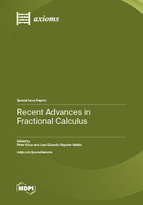Recent Advances in Fractional Calculus
A special issue of Axioms (ISSN 2075-1680). This special issue belongs to the section "Mathematical Analysis".
Deadline for manuscript submissions: closed (31 July 2023) | Viewed by 24236
Special Issue Editors
Interests: mathematical analysis; convex functions; fractional integrals
Special Issues, Collections and Topics in MDPI journals
Interests: fractional calculus; generalized calculus; integral inequalities; qualitative theory of ordinary differential equations
Special Issues, Collections and Topics in MDPI journals
Special Issue Information
Dear Colleagues,
One of the fundamental characteristics of fractional calculus is its two-sided character: on the one hand, it is an area as old as classical calculus (of integer order), and on the other it is up-to-date, making it one of the most dynamic areas of mathematical sciences today. In fact, in recent decades there has been an increase in the number of researchers and publications related to this topic. This increase can be observed in both pure and applied mathematics, in a wide range of areas: from biological models to integral inequalities, through q-calculus, to the study of delayed, neutral, hybrid systems etc. It is interesting that the interaction between specialists from different areas and the mathematicians themselves has provided results that were unthinkable years ago.
All the above means that we can work not only with integral operators of Riemann–Liouville type, but also with differential operators of Caputo or Riemann–Liouville type and their generalizations, with q-calculus operators, with generalized local operators, which gives us the possibility of studying and analyzing phenomena of a very different nature, in a wide variety of problems.
We cordially invite researchers to contribute their original and high-quality research papers in the above topics.
Dr. Péter Kórus
Prof. Dr. Juan Eduardo Nápoles Valdes
Guest Editors
Manuscript Submission Information
Manuscripts should be submitted online at www.mdpi.com by registering and logging in to this website. Once you are registered, click here to go to the submission form. Manuscripts can be submitted until the deadline. All submissions that pass pre-check are peer-reviewed. Accepted papers will be published continuously in the journal (as soon as accepted) and will be listed together on the special issue website. Research articles, review articles as well as short communications are invited. For planned papers, a title and short abstract (about 100 words) can be sent to the Editorial Office for announcement on this website.
Submitted manuscripts should not have been published previously, nor be under consideration for publication elsewhere (except conference proceedings papers). All manuscripts are thoroughly refereed through a single-blind peer-review process. A guide for authors and other relevant information for submission of manuscripts is available on the Instructions for Authors page. Axioms is an international peer-reviewed open access monthly journal published by MDPI.
Please visit the Instructions for Authors page before submitting a manuscript. The Article Processing Charge (APC) for publication in this open access journal is 2400 CHF (Swiss Francs). Submitted papers should be well formatted and use good English. Authors may use MDPI's English editing service prior to publication or during author revisions.
Keywords
- fractional calculus
- q-calculus
- fractional integral and differential operators
- fractional differential equation
- fractional integral equation
- integral inequalities
Benefits of Publishing in a Special Issue
- Ease of navigation: Grouping papers by topic helps scholars navigate broad scope journals more efficiently.
- Greater discoverability: Special Issues support the reach and impact of scientific research. Articles in Special Issues are more discoverable and cited more frequently.
- Expansion of research network: Special Issues facilitate connections among authors, fostering scientific collaborations.
- External promotion: Articles in Special Issues are often promoted through the journal's social media, increasing their visibility.
- Reprint: MDPI Books provides the opportunity to republish successful Special Issues in book format, both online and in print.
Further information on MDPI's Special Issue policies can be found here.






